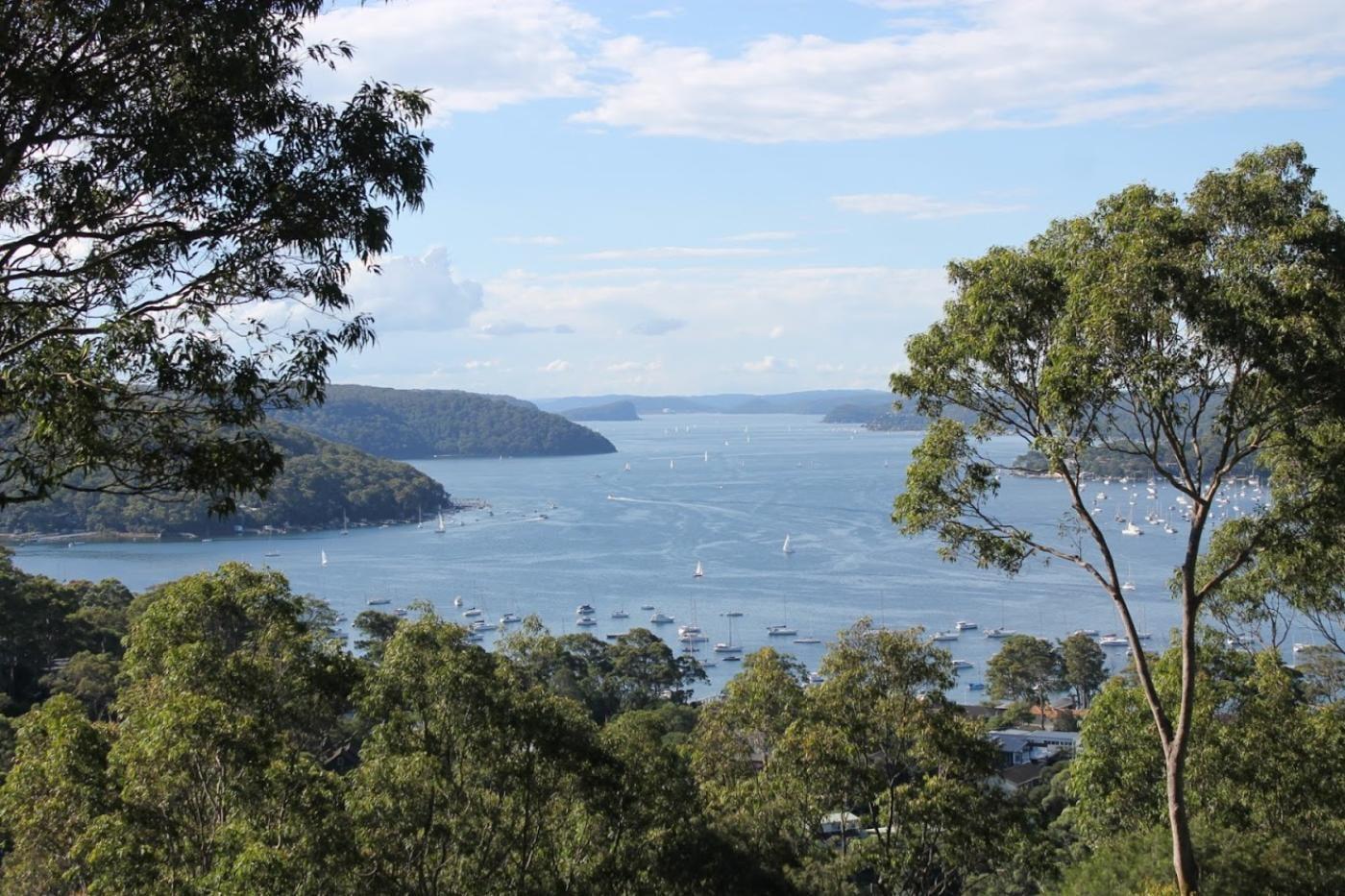February 13 - 19, 2022: Issue 526
Lynette Millett OAM
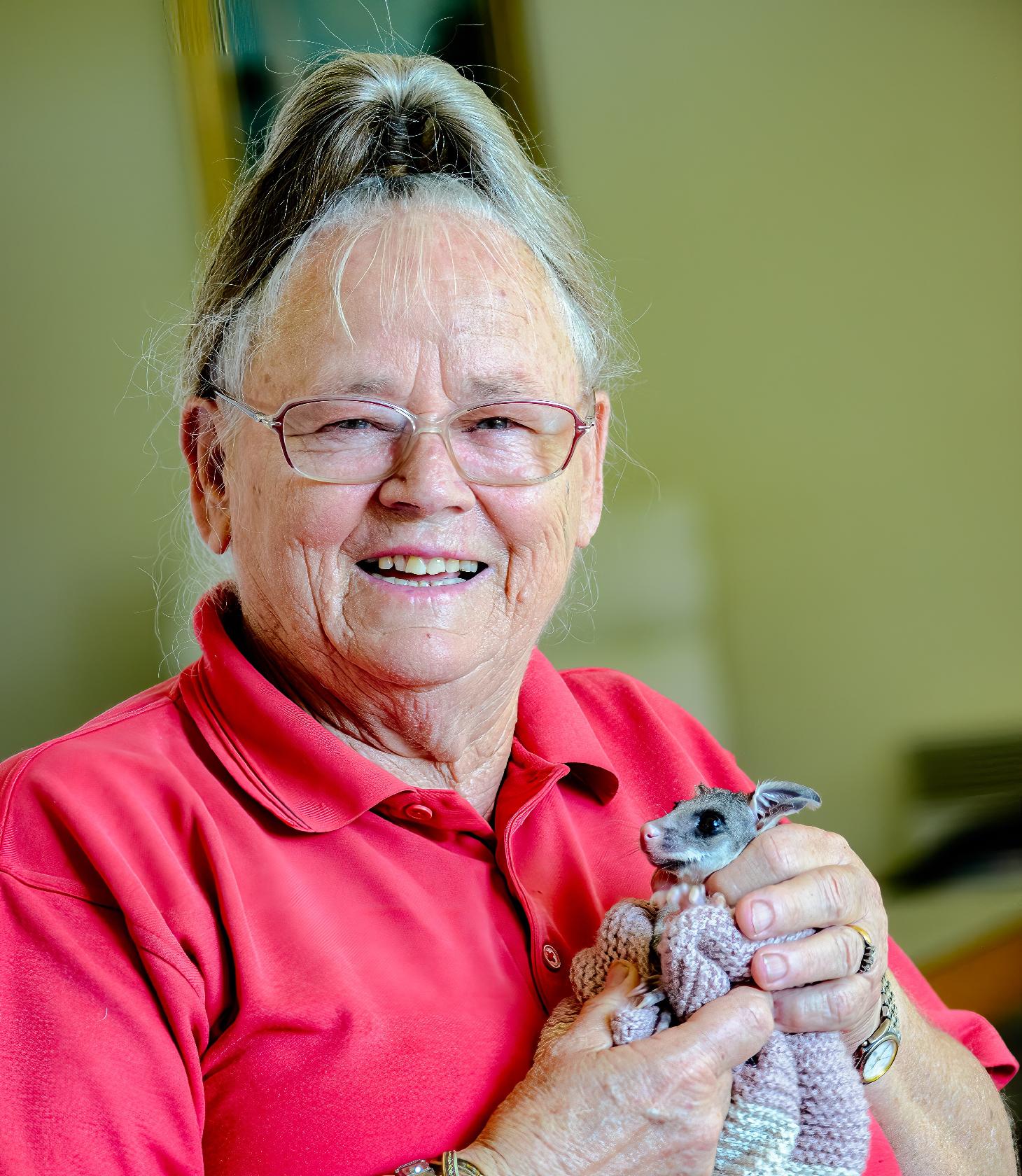
MEDAL (OAM) OF THE ORDER OF AUSTRALIA IN THE GENERAL DIVISION
Mrs Lynette MILLETT, Bilgola Plateau
For service to animal welfare.
Northern Beaches Branch, Wildlife Information, Rescue and Education Services (WIRES)
- Vice Chair, since 2012.
- Beaches Parrot Coordinator, since 2000.
- Possum and Glider Coordinator, since 1996.
- Bandicoot Coordinator, since 1996.
- Seabird Coordinator, since 2000.
- Bat Coordinator, 1996-2006.
- Coordinator, since 1996.
- Food and Equipment Coordinator, since 1996.
Wildlife Information, Rescue and Education Services (WIRES)
- Species Trainer, Small Mammals and Possum and Gliders, 2000-2019.
- Rescue and Immediate Care Course Trainer
- Life Member, 2015.
- Member, since 1995.
Community
- Volunteer, School of Veterinary Science's data collection into possum diseases project, University of Sydney, 2016.
- Past Member, P&C Playtime Kindergarten, Avalon.
- Past Secretary, Avalon Cub and Scouts
- Unit Helper Bilgola Plateau Girl Guides
- Past Member, Meals on Wheels.
- Community Educator (then) Spastic Centre.
- Locker Coordinator Barrenjoey High School
Awards and Recognition include:
- Citizen of the Year, Northern Beaches Council, 2017.
- Northern Beaches Senior Volunteer of the Year 2021
Lyn Millet has volunteered for WIRES for 27 years. She readily shares expertise on possums and gliders by teaching new WIRES members throughout NSW; advises veterinarians; and gives talks to community groups such as scouts, schools, pre-schools, tree loppers, vet nurses and fire brigades. Lyn helps with research into possum diseases by collecting data for Sydney University’s Veterinary Science Department.
It is her work saving our local wildlife that has been a decades long passion for Lynette. At present this Wildlife Carer extraordinaire is asking our community for home sites from brushtail possums, a species that is very territorial and where release into a site already lived in by one possum can result in serious problems and injury. If you have a decent backyard and can help out, Lyn and husband Dave can supply you with a simple pot-drey for a nest and food for their first weeks of adjustment.
Lynette also needs new cages or materials for aviaries - these are needed for the wildlife to exercise and grow the muscles they will need when released back into their own home. Anyone who can help out with either of these can email Lynette at: lynettemillett@iprimus.com.au
As can be read from the list above though, Lynette has been active in our community in many other areas too.
This Issue a few insights into a lady who must have saved thousands of members of our wildlife community by now.
Congratulations on being honoured with an OAM ‘For service to animal welfare’ and in fact, 27 years with WIRES. How did it feel to receive this recognition?
When I first heard about it a couple of months ago I was thrilled of course, but you’re not allowed to say anything until it’s officially announced, and so I had to keep it to myself. But I was thrilled – it’s nice to be recognised by your peers and that’s what gave me the most pleasure, that it was actually people that I work with and know what I do who have nominated me. It’s nice to know that the people you work with think that you’re doing a good job.
You’re a member of the WIRES Northern Beaches Branch as well as a part of the Rescue and Education Services provided through WIRES, and have held a variety of roles; Food and Equipment co-ordinator since 1996, you’ve also been the Bat Co-Ordinator, the Seabird co-ordinator, Bandicoot Coordinator, Possum and Glider Coordinator, and the Parrot Coordinator since 2000?
Yes, I still am most of those things. When you have the experience with the different species people ring you for advice – I always answer my phone so I can help people. I’ve never felt I had to keep my knowledge to myself as by sharing it this enables people to help these animals.
I was just speaking to the membership officer at the head office for WIRES – when I first joined was when Sydney Wildlife split from WIRES and all our committee members went to Sydney Wildlife and we had all these new people who were thrown in at the deep end and I ended up on what was then the Board as the representative for our Branch, and Possum Co-Ordinator from then on in my career with WIRES. There was also one year or so then when we just couldn’t pay an administrator to run our office so I got that job because I lived the closest.
How many hours of volunteer work are you doing each week to help our wildlife?
It’s a full time job for me. I have only just finished all the animals now and then I’ll start feeding baby possums again at 1pm. In between time I also have to do all the paperwork. Every animals has what’s called a Call Sheet that comes with it which has to be passed on to somebody else if that animals goes to them.
You also have to update the Call Sheets for all your rescues – yesterday we did 3. So it’s imperative you keep up to date with all the paperwork – that’s what I find the hardest. Any bit of spare time I have I’m usually on the computer trying to update the records of all the animals I have in care.
I come up from feeding all the possums and birds around 7 - 7.30pm and have to prepare dinner. Then at 9.30pm we start feeding baby possums again.
How many do you have in care at present?
Yesterday I got 5 baby ducklings in. I have a magpie, sick Figbird baby, a baby water dragon, a baby silver gull, 6 rainbow lorikeets, 4 baby tawny frogmouths, 5 juvenile brushtail possums, 2 blind mums with babies; 1 is a brushtail possum with a joey and the other is a ringtail with 2 joeys – so we let them raise their babies in care so the mums and the babies are safe and they can look after them until the babies are big enough to be released. Then we have all the babies upstairs. So I have a little baby brushtail in the humidicrib, which is fed 4 times a day, and we have two baskets full of our little baby ringtails. Some are on 4 feeds a day and some are 3 feeds a day.
That’s a zoo!
That’s right, it is like a zoo. Occasionally I have had small groups of children visit from schools. I tell them about the animals I have in care and how we look after them. The other day I was asked if a Scout Group could come up and have a look at what we do. I have had several Duke of Edinburgh students work with me towards their award, and they are a great help.
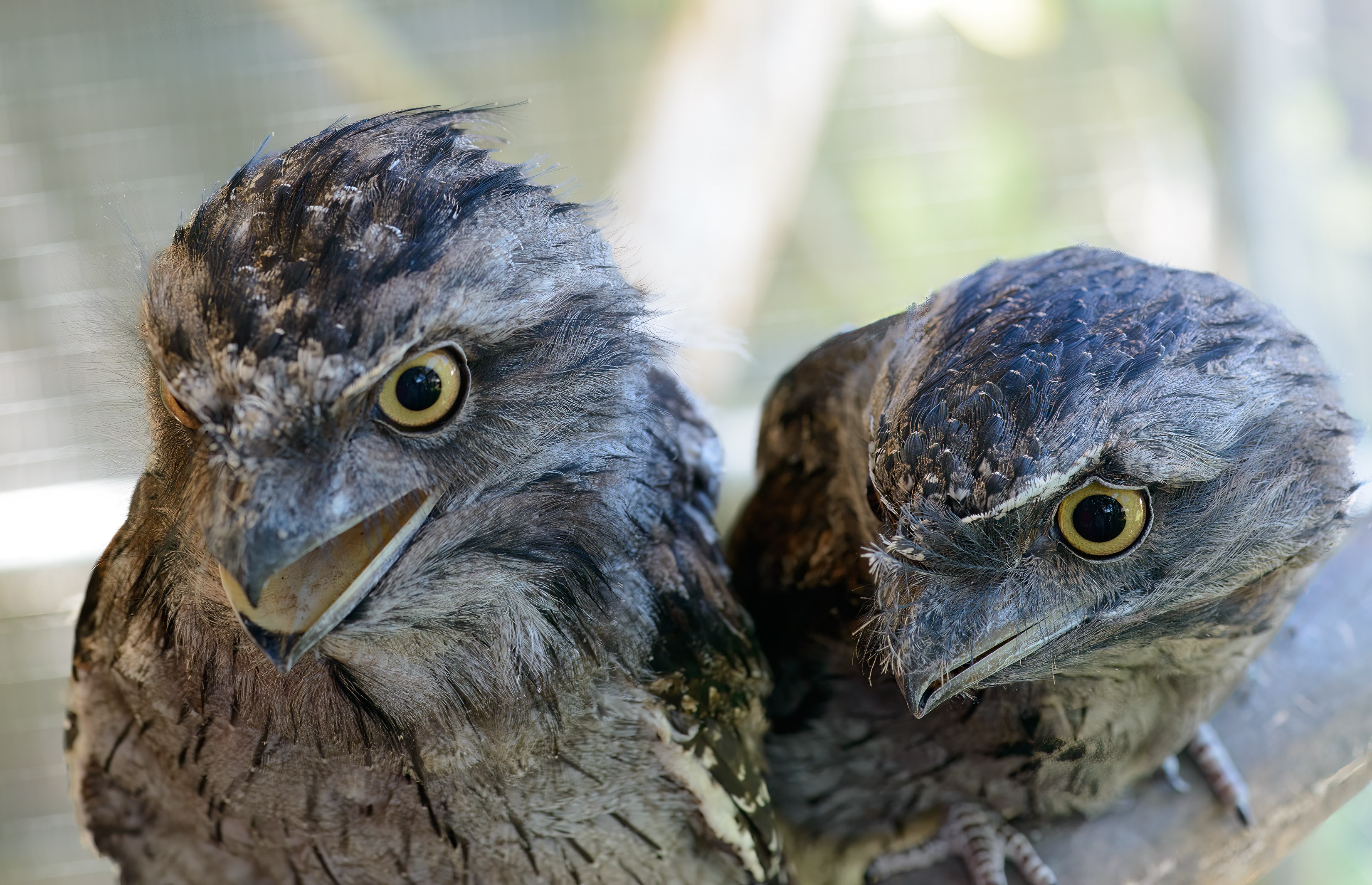
Tawny Frogmouths in care. Photo: Michael Mannington, OAM
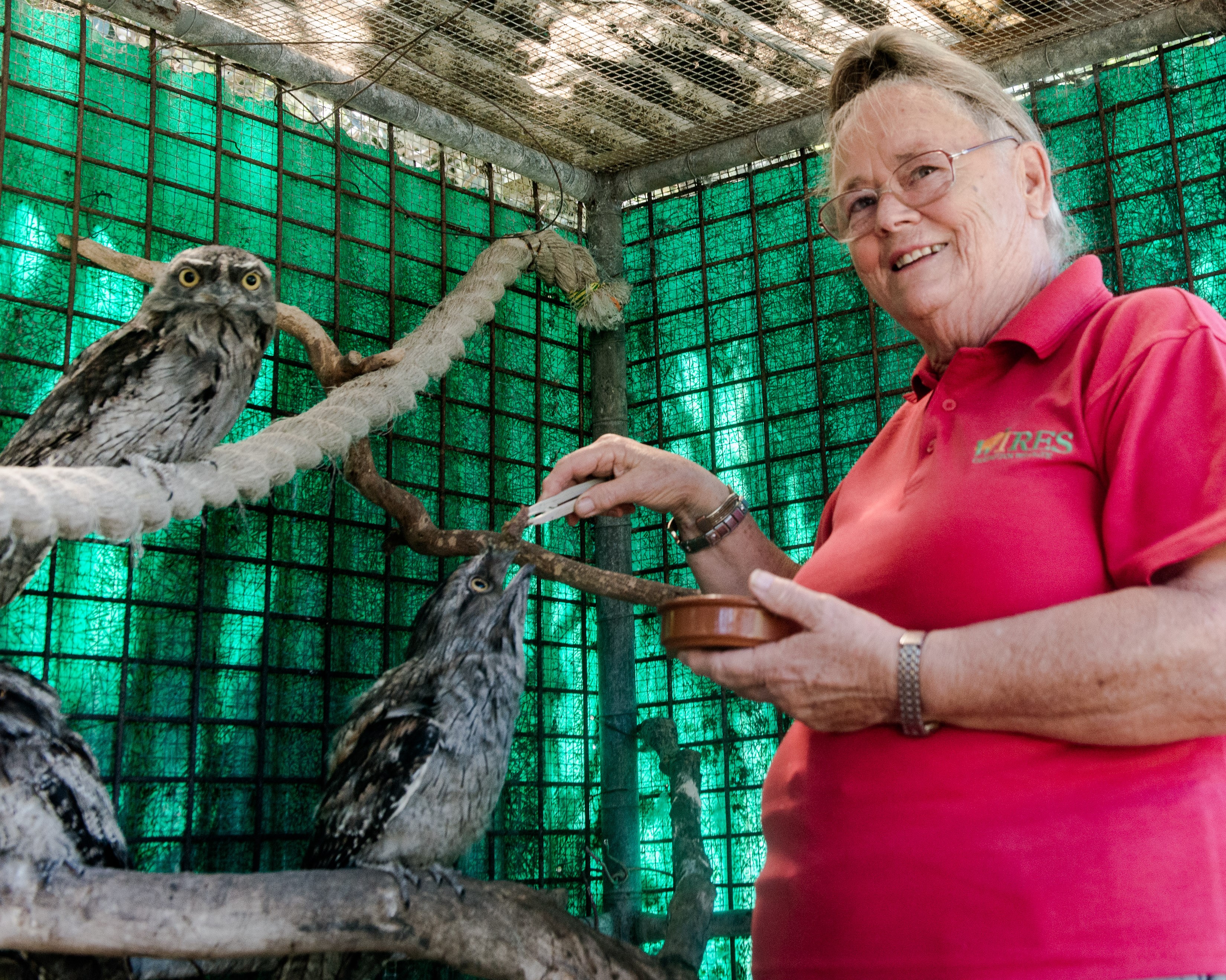
Lyn feeding Tawny Frogmouths. Photo: Michael Mannington, OAM
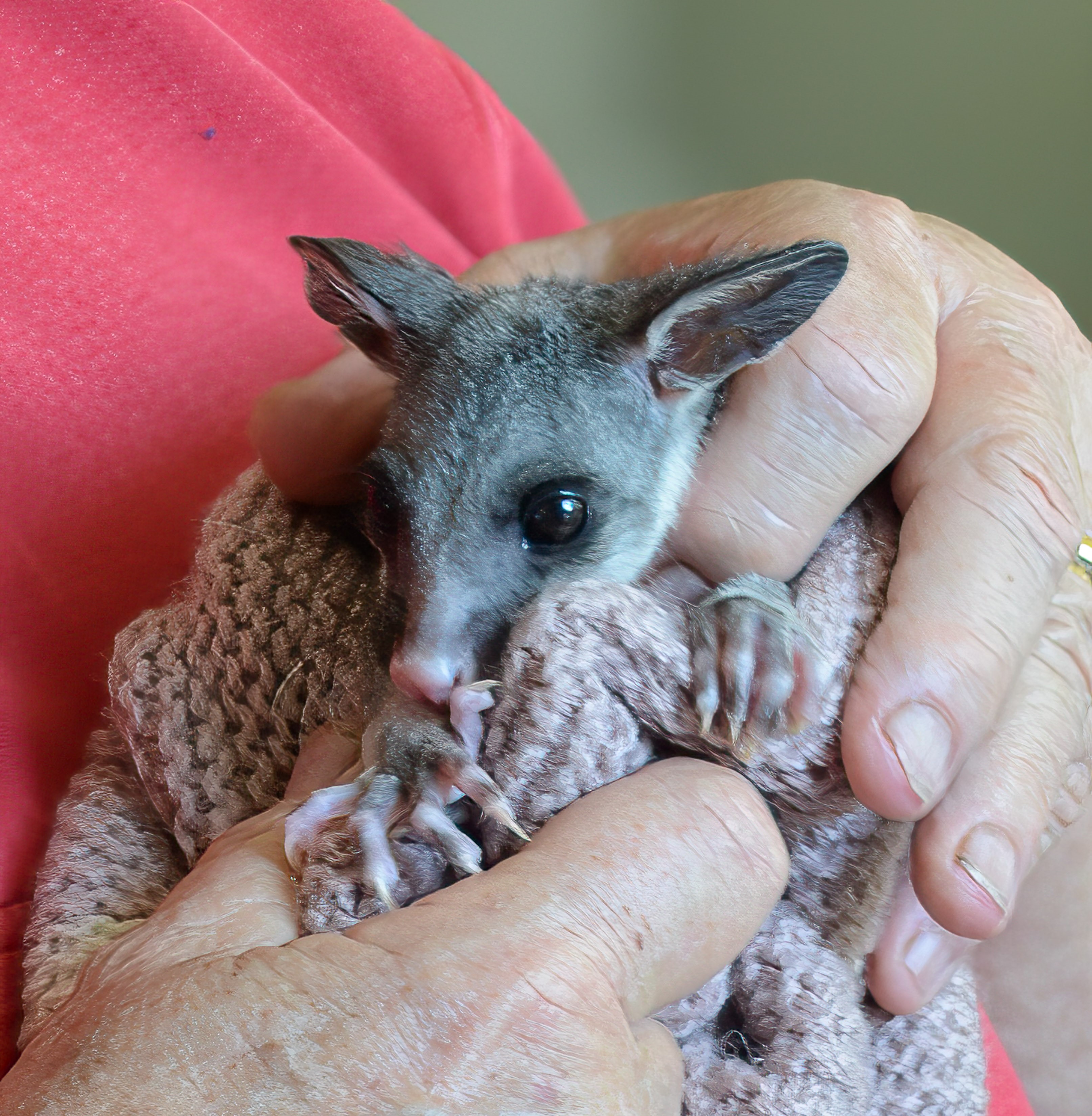
Baby Brushie in care. Photo: Michael Mannington OAM
How important is it to educate the next generation on how vital our wildlife is and how people like yourself are trying to save them?
I find that this generation, and the last one, are a lot more environmentally aware than my generation was, or my parents’ generation. I can remember when I was a child the only good snake was a dead snake.
I think nowadays the young people are a lot more aware and we have a lot of these joining WIRES to do what they can. It’s good to be able to have a chat to youngsters about what each species eats and what we can plant in our garden for them. Having an environmentally friendly garden helps our wildlife – or showing them simple homes that we make out of pots that we then put up in the trees for the possums to have a temporary home.
How many carers are there locally – do you need more members?
We have over 200 people in our Branch but as with any organisation, you have that hard core group that do most of the work and that’s about 20 people with us. You have to face the fact that young people have a lot going on and everyone is living a very busy life; they’re working or studying and simply haven’t got the time. Their careers can be more than full time jobs and then they may go to the gym or they’re studying at night and haven’t got the time to commit. When you take on an animal then that animal is your responsibility and you have got to do what you have to do to get it back out there, to the release stage. Whether it’s vet visits or collecting native food for them, or feeding – it all takes time.
It’s even the same if they’re just rescuers. Last November I trained two classes – I do the Rescue and Immediate Care courses, and we trained about 50 people. Of that 50 there’s only about 10 that have run with it and done rescues. A lot of people think it may be great but then when they rescue an animal, they usually have to take it to a vet then call back to collect it and then on to a carer. That all takes time – half a day is gone.
Are the costs involved off-putting for some volunteers?
We’re really lucky in that since the 2020 bushfires and WIRES getting so much money donated our specialist food is paid for now. Prior to this head office would pay for half and we would fundraise in our Branch for another 25%. So instead of it costing me $16 for a container of possum milk it would cost $4, but now, it’s all free – I can ring up and put in an order say for mice to feed my tawnies and kookaburras and the office pays for that. Our facilities and equipment we still have to pay for but we do get a lot donated. The running around, the petrol costs involved, that doesn’t worry a lot of people, it’s the time involved as everyone is time poor these days.
I always thought retirees would find this volunteer work appealing but then retirees want to be able to get in their caravan and go off at the drop of a hat, they don’t want to be tied down.
So a lot of people embrace WIRES but don’t stay simply because it’s too much work.
Why have you stayed Lyn?
Because I love animals. I always wanted to be a Vet when I was a kid.
When my children were in High School, Dave and I bought a yacht and went and did our Yacht Masters at Tech, which involved quite a few years of different courses; meteorology and seamanship etc. – it’s quite extensive.
After that I said, right, now you can come and do WIRES with me. So we then went and did the WIRES Course together.
I couldn’t do it without my husband’s support. If he wasn’t there to help me, I just couldn’t do it. He’s really patient, and really good with all the baby possums. He helps me with all the hand feeding and if I’m still downstairs feeding all the other animals he’ll come up and do all the 4 or 5 o’clock feeds for all the babies. At night time we both sit there and feed them, in the morning we both sit there with a basket each of babies and feed them. He’s the one that climbs up the ladders to release animals. He repairs all the cages, at the moment he’s rewiring one of our aviaries. He makes all the dreys for us and for the other possum carers in our branch.. He’s my rock really.
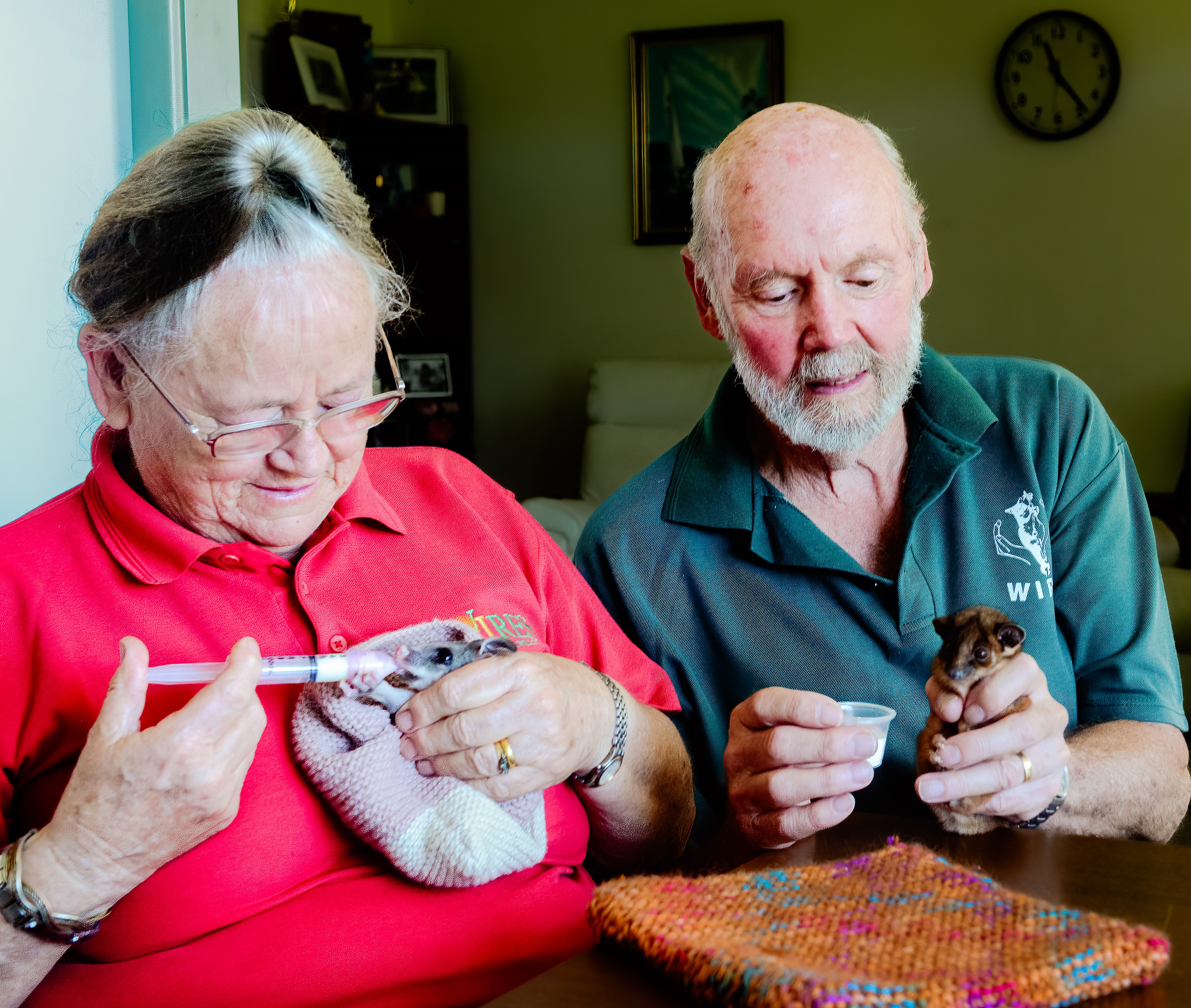
Lynette and Dave feeding babies. Photo: Michael Mannington, OAM
You and Dave have been on Bilgola Plateau for 50 years this week – another wonderful anniversary. Why did you move to Bilgola Plateau?
We came from Balmain. I had always lived in Balmain East, on the harbour. A lot of people form down that way seemed to gravitate up here because land was quite cheap in those days. We initially bought a block of land down in Newport but then realised it was just too steep and we couldn’t afford to build on it. We then bought a little beachcomber house, a 2 bedroom one that we’re still in now, and my husband converted it to 3 bedrooms at the top and then he built a flat underneath for his parents. They came out from Wales and wanted to stay – my husband in Welsh – so he built that for them. Our little beachcomber has now ended up becoming quite a big house.
It’s not just almost three decades of investing in WIRES, you have also held several volunteer positions in our community over the years; you have helped out at the football club, the Avalon Market Place, the Grass Skiing Association, are a Past Member, P&C Playtime Kindergarten, Avalon, Past Secretary, Avalon Cub and Scouts, Unit Helper Bilgola Plateau Girl Guides, Past Member, Meals on Wheels, Community Educator (then) Spastic Centre and even the Locker Coordinator Barrenjoey High School. Where was the Grass Skiing done?
My brother was actually Australian Champion Grass Skier. This was in the mid 1980’s to 1990’s, when Grass Skiing was quite popular. It was also popular overseas as a training medium for the snow skiers, where they would grass ski in the Summer to keep up their fitness.
We had a few Grass Ski Parks here too – there was one at Kurrajong, one at Jamberoo – Jamberoo actually started off as a Grass Ski Park – and there was also one at Moore Park.
We hosted the Pan Pacific Championships here during that time that I was involved as the Secretary. My eldest son was a Junior Australian Champion as well
The thing is, I always felt that if my children were involved in something that it was really my responsibility to help out. I didn’t think it was right just letting other people do all the work.
Therefore when they were at school I was a school helper, a class mum or one of the mums on the fete committees and whatever else was needed.
When they went to High School at Barrenjoey I ended up getting the job for a lot of years as the one looking after the lockers.
What did being the Locker Coordinator Barrenjoey High School involve?
It meant cutting the keys for all the lockers; and every week somebody would have lost their key; I had a key-cutting machine. Every Wednesday morning I’d go down to attend to that. They kind of lumbered the Lost Property with me as well – so I had all the Lost Property to sort out. If there was a name on it I could go and open the locker and put the item back in, so that worked well.
At the beginning of the year we hired out all the lockers, and a few of the mums would come and help me. At the end of the year we got them emptied and gave their deposits on their keys back, if they still had their keys. Some of the lockers were used the first week but then never used again – so at the end of the year when we opened those lockers it was quite terrible – there were lunches that were a year old ! (laughs)
During that time my husband used to go and repair them all as well.
When I finished up I’d actually raised $15, 000.00 for the school. That money resurfaced their football field as they’d just had a new hall built and the football field had been damaged during the building.
I left when my last child left – I have three children. My eldest is 50 today and that’s how I know I’ve lived here for 50 years as we didn’t move in until he was born.
Outside of school you were a Unit Helper Bilgola Plateau Girl Guides – where did this Group meet?
At Bilgola School. I’m not sure if they’re still going now. They hadn’t been going very long when my daughter joined. When she left I left as well – same with the Scouts; I was only Secretary of the Committee during the time they were in Cubs and then Scouts. I left then as I felt it was time for the new parents to take over.
I’ve always felt if you’re children are involved then you should be involved too , not just to know what’s going on but to help out
You also were a volunteer for Meals on Wheels?
Yes, I did that for quite a few years with a friend. Once a week we used to do Meals on Wheels in the Fairlight area, that was our run.
Community Educator for the Cerebral Palsy Alliance, formerly known as the Spastic Centre – what was involved doing that?
That was my paid job and the last job I did before retiring to do full time WIRES work. I used to work around 3 days a week training adults in life skills and used to take the animals to work with me – they used to love watching me feed them.
The Avalon Market Place – where did that start?
This started as a co-operative in a shop in Bellevue Ave. Avalon and in later years moved to a cottage in Old Barrenjoey Road. This was when I first moved up here and had a young baby and started doing craft work. I worked with shells, covering pots with shells and made little shell animals. So next thing, I ended up as Secretary of that for quite a few years, I was a stenographer so could take notes and type them up
That’s an amazing lot of service over decades Lyn - when do you sleep?
(laughs) I sleep really well – as soon as my head hits the pillow, I’m asleep. I like being busy, I’m not a person that can just sit around and do nothing and am always looking for something to do. The only time I get to read is when we’re on holidays – I love reading but always think there is something more important I should be doing.
Getting back to your volunteer work for WIRES – what’s the best part of that for you, what do you love about it?
Nursing the animals back to health and then releasing them.
If you have, for instance, a sick possum and he’s on death’s door; he can’t stand up and he’s lying on his side, and you can rehydrate him, medicate him, and nurse him back to health with good food, and then release him so he has another chance out there, that’s what we do it for.
Some carers have told us they’re running out of places to release animals to, particularly so with brushtail possums, which are notoriously territorial. Are you having that problem too?
We are. If I go and rescue a possum that then sadly has to be euthanised, I always ask the people if they’re willing to foster a couple of joeys. At our stalls when we have markets we always have a little sign up asking people if they’d be willing to foster them for us.
What we do in these instances is, when they’re ready for release, we take them in the home they are used to living in and put it up in somebody’s backyard, we then attach a basket nearby for the home owner to put fruit and vegetables in (which we are happy to supply) only for a couple of weeks. This type of release works well as the home owners take an interest in the possums and are able to contact us if anything goes wrong. They survive really well doing it this way.
Studies done on possums just simply released back into the bush show they’ve just sat in their possum box for a week before they’ve been able to come out they’ve been so frightened.
That’s why we always buddy them up, so they always have a little buddy to go out with and this gives them a bit of bravado. We always place them with people in suitable sites and find that if we can get someone to soft release them in their backyard and look after them that this is the best way for their survival.
With the ringtails it doesn’t matter – we can always find nice reserves to put the groups in because they don’t need support feeding – as long as they have plenty of native plants for food, that’s all they need. But the brushies are a bit more special and need a bit more TLC when they go out because most times they’ve been raised from pouched young and they don’t have the wild instincts that their mothers pass on to them.
How can the local community support your work with WIRES?
Well, they can offer to release for us if they’ve got a suitable backyard and no dogs that are going to attack them. We’re always looking for good release sites. So if they haven’t got a lot of possums around and they’d be happy to support feed for us. We have them coming up for release right throughout the year.
They can email me at lynettemillett@iprimus.com.au – I’d love to hear from them.
The other thing is we’re always happy to take donations of larger cages or aviaries. If someone has a parrot that has died they can always contact our head office and they will let us know where to pick up from.
We have to buy all our own equipment so it helps if we can source donated items, aviaries and cages. One of our biggest problems is we don’t have enough aviary space throughout our branch and all the little possums that we raise have got to go into an aviary for their last bit of rehabilitation so they can run around and build up their strength and those muscles they’ll need when released. My aviaries are always at a premium – people are always waiting on a space there, especially so in the busy seasons.
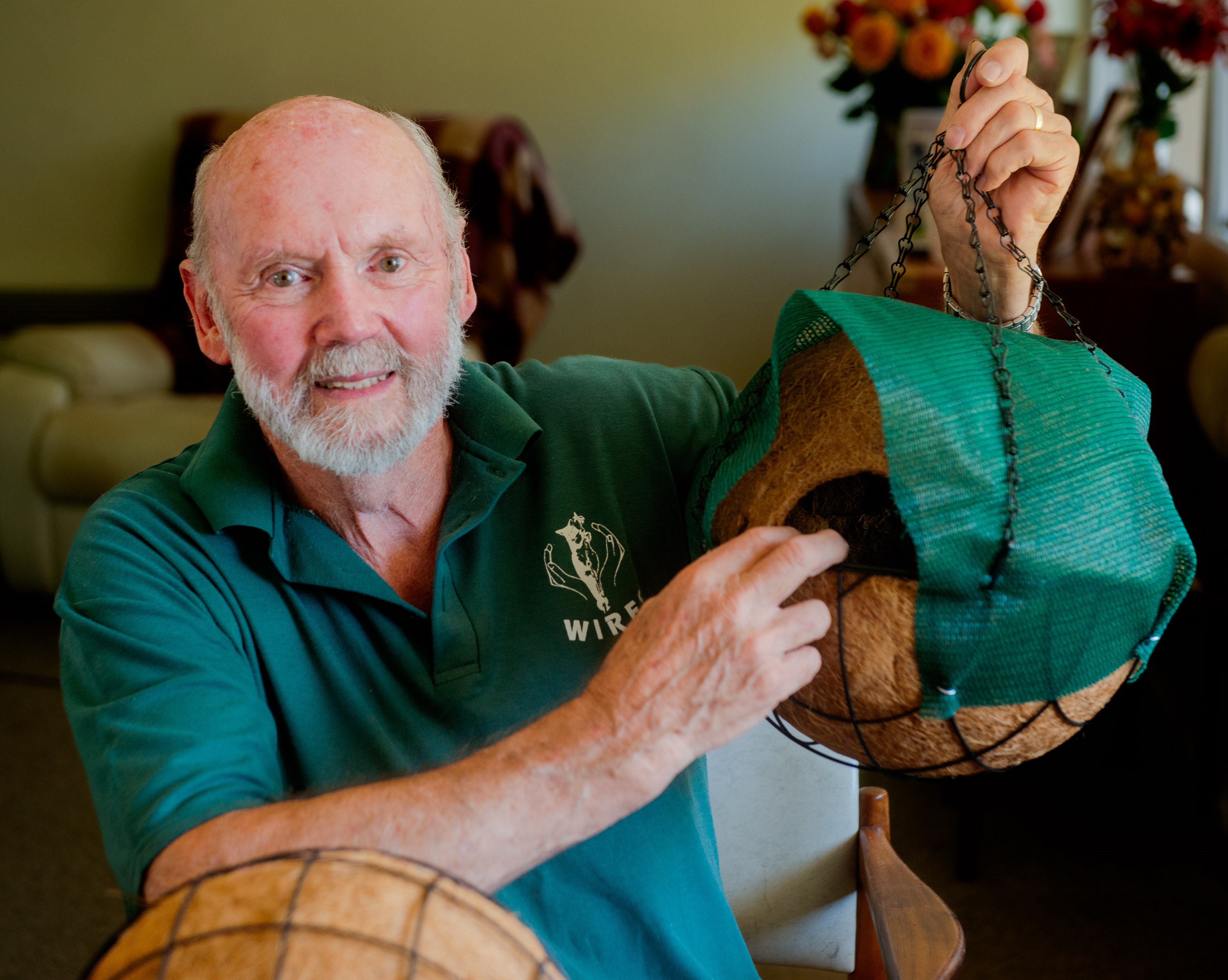
Dave with one of the homes he builds for the possums. Photo: Michael Mannington OAM
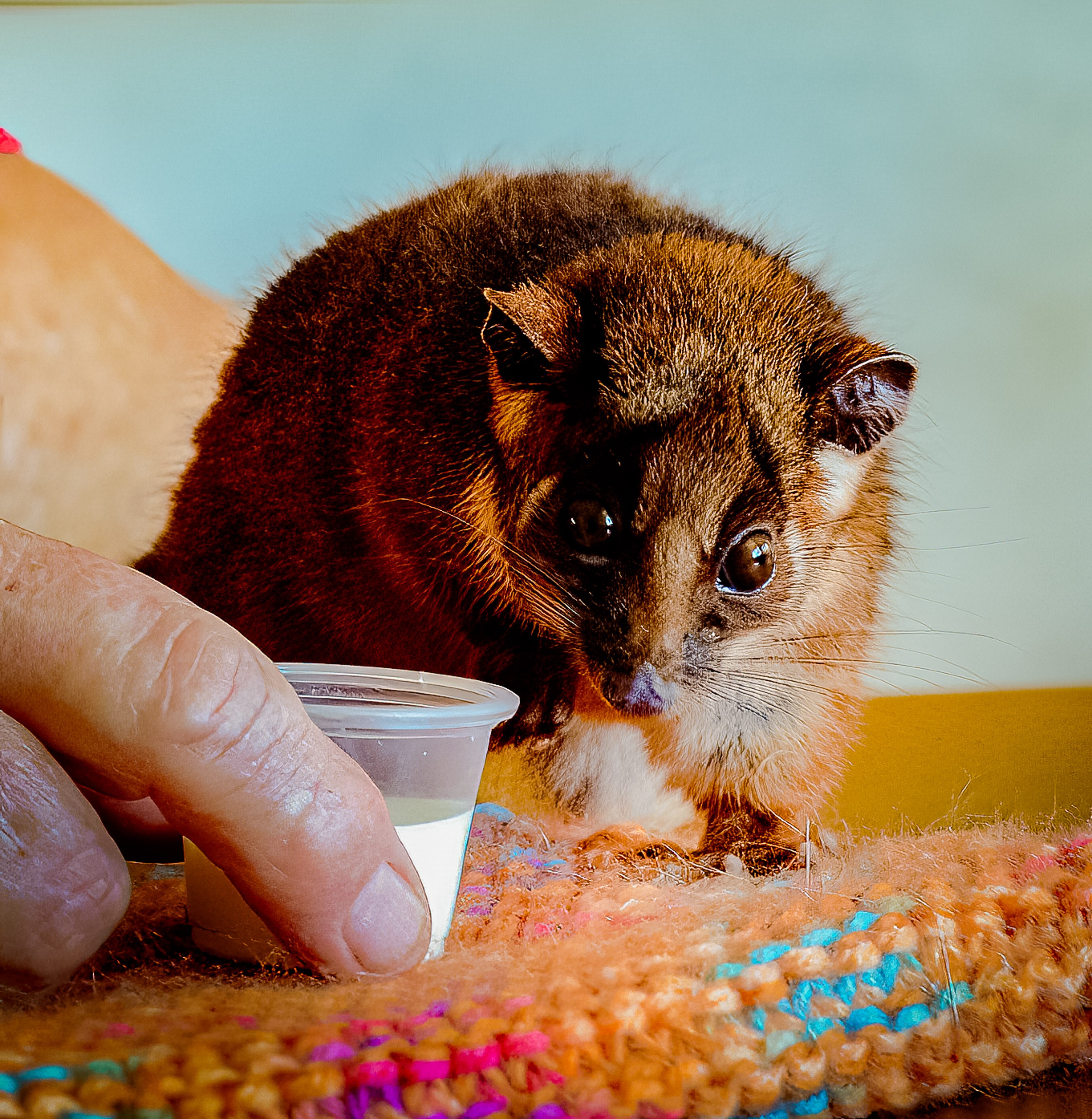
Baby Ringtail in care. Photo: Michael Mannington OAM
What are the busy seasons?
We have two main times when we have possum joeys coming into care – the first is in July-August-September; when we get the Summer ones that are just emerging. The other times is now, February, when we have the Spring births, those are all just emerging now and getting into trouble.
While they stay in mum’s pouch they’re pretty safe. When they’re riding on mum’s back things can go wrong.
What are your favourite places in Pittwater and why?
I love Pittwater, the waterway itself. We spend a lot of time on the water when time permits – our 35 foot sailing boat is down on Pittwater - although our children use it more than we do nowadays.
We have taken time off over the years and cruised up to Lizard Island and we’ve cruised to New Guinea a couple of times to the Louisiade Archipeligo and the Lachlan Islands and spent time there with native villagers who have no cash economy and hardly any contact with the outside world, a really primitive and special place. They are such lovely gentle people.
You have to know you have a good boat and you have to know what you’re doing – we did do our Yacht Masters. You are on your own out there and you have to make sure you’re sensible and look after yourselves.
So I really love this area and sailing on the waterways in particular.
In between the feeds?
That’s right, although mind you, I have been known to take my possums out on the boat. Yes, rowing out in the dinghy with my basket full of joeys – there’s no reason why you can’t feed babies on a boat.
What is your ‘motto for life’ or a favourite phrase that you try to live by?
Do unto others as you would have them do unto you.
